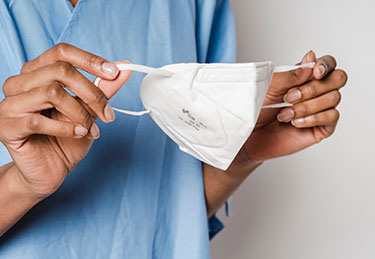Workers who are at risk for airborne health hazards — including public health professionals — need better guidance on how to protect themselves, a recent report says.
Released in February by the National Academies of Sciences, Engineering and Medicine, the report calls for respiratory device frameworks that can be used to better protect workers from current and future airborne threats. Such information would help workers know which type of respiratory devices to use, how to use them and where to get them, according to “Frameworks for Protecting Workers and the Public from Inhalation Hazards.”
“The COVID-19 pandemic, the threats of wildfire smoke and mold growth from flooding have made us well aware of the dangers in the air we breathe both indoors and outdoors and the possible harms to health,” Jonathan Samet, MD, MS, dean of the University of Colorado’s School of Public Health and chair of the committee that wrote the report, said in a news release.
While federal regulations that limit exposure to hazardous substances apply to most U.S. workers, it has long excluded others, leading to gaps. New frameworks should apply to all types of workers, including essential and gig economy employees, the report said.
Also, the public is in need of guidance, the report noted.
Changing guidance on respiratory devices — as was seen during the first two years of the COVID-19 pandemic — can lead to misinformation, according to Sarah Coefield, MS, MA, a report co-author and air quality specialist at Montana’s Missoula City-County Health Department. Health officials should work with the public to form centralized messages that are adaptable to community needs, she said.
“We recognize that it is important that everyone in the public have access to meaningful guidance about respiratory protection,” Coefield said during a report release event. “Harmonizing the guidance from all the agencies who may be getting that information out about respiratory protection for the public and also making sure they’re gathering input on that guidance (is important).”
The report recommended that the U.S. Department of Labor oversee respiratory protections for workers, while the U.S. Department of Health and Human Services lead initiatives for the public.
HHS should develop and fund research on respiratory protective device effectiveness, including fit and breathability, the report recommended. More research should also be conducted on the needs of vulnerable populations, such as children, seniors and people with pre-existing health conditions, the authors said.
Communication on protective devices can be customized for vulnerable populations, Mary Rice, MD, MPH, a member of the committee and assistant professor of medicine at Harvard Medical School, said.
"Children and elderly adults with chronic diseases who have specific needs may require advice…that might be different from other members of the public,” Rice said during the release event.
The committee also highlighted problems with the respiratory protective device supply chain, which has affected access to masks and other devices during the pandemic. The authors suggested that federal agencies develop usage estimates and distribution guidelines to ensure the devices are available during emergencies. The availability of respiratory devices will become even more important in the U.S. because of health threats caused by climate change, they said.
The report was sponsored by the CDC Foundation, U.S. Department of State, U.S. Environmental Protection Agency and the National Institute for Occupational Safety and Health.
Photo by Klaus Nielsen, courtesy Pexels